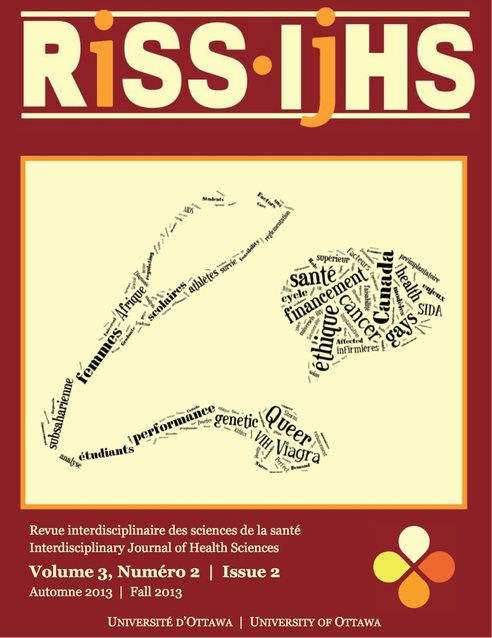Sub-Saharan Women Affected by HIV/AIDS: The Perfect Storm of Risk Factors
DOI:
https://doi.org/10.18192/riss-ijhs.v3i2.1339Keywords:
HIV/AIDS, Sub-Saharan Africa, women, risk factors, genderAbstract
This paper explores women’s health in the prevalence and incidence rates of HIV/AIDS in sub-Saharan Africa. The risk factors presented in the literature that are hypothesized to be responsible for the increasing rates of HIV/AIDS in sub-Saharan African women are identified. Risk factors discussed include biological factors, parasites, malnutrition, lower socioeconomic status, intimate partner violence, war, gender inequality and lack of education. These risk factors relate to multiple determinants of health: income and social status, education and literacy, employment, physical environment, gender and culture. The authors present their perspectives on mediating this epidemic, which involves reducing the ramifications of poverty on sub-Saharan women.
References
Bleich, S. N., Jarlenski, M. P., Bell, C. N., & LaVeist, T. A. (2012). Health inequalities: Trends, progress, and policy. Annual Review of Public Health, 33, 7-40. doi:10.1146/ annurev-publhealth-031811-124658
Campbell, J. C., Baty, M. L., Ghandour, R. M., Stockman, J. K., Francisco, L., & Wagman, J. (2008). The intersection of intimate partner violence against women and HIV/AIDS: A review. International Journal of Injury Control and Safety Promotion, 15(4), 221-231. doi:10.1080/17457300802423224
Feldacker, C., Ennett, S. T., & Speizer, I. (2011). It’s not just who you are but where you live: An exploration of community influences on individual HIV status in rural Malawi. Social Science & Medicine,72(5), 717-725. doi:10.1016/ j.socscimed.2011.01.003
Fox, A., Jackson, S., Hansen, N., Gasa, N., Crewe, M., & Sikkema, K. (2007). In their own voices. Violence Against Women, 13(6), 583-602. doi:10.1177/1077801207299209
Gill, K., Pande, R., & Malhotra, A. (2007). Women deliver for development. The Lancet, 370(9595), 1347-1357. doi:10.1016/S0140-6736(07)61577-3
Greif, M. J. (2012). Housing, medical, and food deprivation in poor urban contexts: Implications for multiple sexual partnerships and transactional sex in Nairobi’s slums. Health and Place, 18(2), 400-407. doi:10.1016/ j.healthplace.2011.12.008
Hallman, K. (2005). Gendered socioeconomic conditions and HIV risk behaviours among young people in South Africa. African Journal of AIDS Research, 4(1), 37-50.
Heimer, C. A. (2007). Old inequalities, new disease: HIV/ AIDS in sub-saharan africa. Annual Review of Sociology, 33, 551-577. doi:10.1146/annurev.soc.31.041304.122203
Himmelgreen, D. A., Romero-Daza, N., Turkon, D., Watson, S., Okello-Uma, I., & Sellen, D. (2009). Addressing the HIV/AIDS—food insecurity syndemic in Sub-Saharan Africa. African Journal of AIDS Research, 8(4), 401-412. doi:10.2989/AJAR.2009.8.4.4.1041
Lauer, H. (2006). Cashing in on shame: How the popular “Tradition vs. modernity” dualism contributes to the “HIV/ AIDS crisis” in Africa. Review of Radical Political Economics, 38(1), 90-138. doi:10.1177/0486613405283319
Mabala, R. (2006). From HIV prevention to HIV protection: Addressing the vulnerability of girls and young women in urban areas. Environment & Urbanization, 18(2), 407-432. doi:10.1177/0956247806069624
Magadi, M., & Desta, M. (2011). A multilevel analysis of the determinants and cross-national variations of HIV seropositivity in sub-Saharan Africa: Evidence from the DHS. Health and Place, 17(5), 1067-1083. doi:10.1016/ j.healthplace.2011.06.004
McInnes, C. (2009). Conflict, HIV and AIDS: A new dynamic in warfare? Global Change, Peace & Security, 21(1), 99-114. doi:10.1080/14781150802659440
Morrison, A., Raju, D., & Sinha, N. (2007). Gender Equality, Poverty and Economic Growth. Policy Research Working Paper 4349. Retrieved from http:// www.development.wne.uw.edu.pl/uploads/Courses/ DW_additional_gender.pdf
Oster, E. (2005). Sexually transmitted infections, sexual behavior, and the HIV/AIDS epidemic*. The Quarterly Journal of Economics, 120(2), 467-515. doi:10.1093/qje/120.2.467
Public Health Agency of Canada. (2011). What determines Health. Retrieved from http://www.phac-aspc.gc.ca/ph-sp/ determinants/#determinants
Rodrigo, C., & Rajapakse, S. (2010). HIV, poverty and women. International Health, 2(1), 9-16. doi:10.101;p’6/ j.inhe.2009.12.003
Sacks, A., & Levi, M. (2010). Measuring government effectiveness and its consequences for social welfare in sub-Saharan African countries. Social Forces, 88(5), 2325- 2351. doi:10.1353/sof.2010.0044
Stillwaggon, E. (2008). Race, Sex, and the Neglected Risks for Women and Girls in Sub-Saharan Africa. Feminist Economics, 14(4), 67-86. doi:10.1080/1354570080226292
Stockemer, D., & Lamontagne, B. (2007). HIV/AIDS in Africa: Explaining the differences in HIV prevalence rates. Contemporary Politics, 13(4), 365-378. doi:10.1080/13569770701822847
World Health Organization, UNAIDS, UNICEF. (2011). Global HIV/AIDS response: Epidemic update and health sector progress towards universal access: Progress report 2011. Retrieved from http://www.who.int/hiv/data/en/
Downloads
Published
Issue
Section
License
- All authors published in the IJHS will retain copyright of their article.
- Authors grant the IJHS the right of first publication of their submitted articles.
- All articles published in the IJHS are licensed under a Creative Commons Attribution License that allows others to share articles if original authors and journal of initial publication are acknowledged.
- The IJHS is published online and in print, therefore the journal is not responsible for any unauthorized misuse of published content in either electronic or print form
- The IJHS retains the serial distribution rights to all contents
- It is the responsibility of the authors and not the IJHS to ensure proper permissions for all cited work have been obtained


